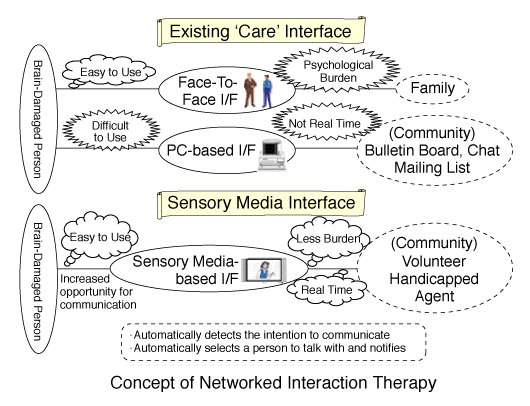
 |
| ■ Networked Interaction Therapy for Mildly Brain-Damaged People | ||
TETSUTANI Nobuji, Intelligent Robotics & Communication Laboratories People who have suffered mild brain damages due to senescence or cerebrovascular illness may look ordinary at first sight, however it is difficult for them to lead a normal social life. Often, the requirement for constant care and attention creates a burden for their family members. A possible method for reducing this stress is to enable the disadvantaged person to participate in a networked community. However, brain damaged people cannot operate a personal computer. In this project, we are investigating novel interfaces which will allow the mildly brain-damaged to participate in networked communication without having to operate a computer. Recent advances in image understanding and sensory interaction media technologies allow us to develop such a novel interface. This kind of 'sensory media interface' will provide effective therapy, relieving both the stress suffered by the brain-damaged and easing the burden on their family members. An intelligent user interface, which does not require operating a personal computer, is required to connect the brain-damaged person both with a networked community as well as with her/his family members. The networked community consists of other brain-damaged persons, volunteers, and family members as well as software agents. Interaction with all elements of the networked community is intended to satisfy the need of the brain-damaged to communicate. Since operation of a personal computer may be difficult for them, it is necessary to devise a means to detect their intention to communicate with others. After the intention to communicate is detected, s/he is automatically connected to the network community. As the brain-damaged tend to suffer attentional deficits, a method will be developed to keep their attention focused on interacting with the networked community. Furthermore, when a request to communicate is initiated by one member of the community with another, it is necessary to notify the person requested. For this purpose, we will develop a notification method based on sensory stimuli. In addition, a networked community platform needs to be developed. In order to achieve these objectives, the following three sub-themes are pursued.
This research is supported in part by Telecommunications Advancement Organization of Japan. |
||
 |
| ■ ATR Research Exposition 2003 | ||
ATR Research Exposition is held annually to showcase the latest achievements and developments from ATR's research laboratories, and to promote business opportunities for our research findings. The Research Expo for 2003 took place on November 6-7, and was attended and enjoyed by over 1,100 visitors, among them colleagues from the industrial, academic and governmental organizations with which we enjoy a close professional relationship. New to the lecture program this year was a "Research Vision" lecture, given on November 6 by Dr. Mitsuo Kawato, Director of the Computational Neuroscience Laboratories, which were inaugurated in May 2003. Another innovation at the 2003 Expo was an invited lecture on November 7, given by Dr. Hideyuki Tokuda of Keio University on the outlook and issues for a ubiquitously networked society. Other features over the two days included seven lectures presented by various ATR laboratories, and 95 presentations, including laboratory demonstrations and poster sessions. This represents one of the largest number of presentations ever held at an ATR Expo. |
||
 |